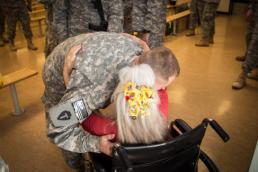Story by: Maj. Randall Stillinger
Posted: Feb 24, 2015
 |
Maj. Randall Stillinger
A Soldier from the 1-112th Cavalry Regiment, 72nd Infantry Brigade Combat Team, receives a hug from Elizabeth Laird before boarding a plane at Robert Gray Army Airfield on Sep. 13, 2015. Laird is commonly known as “The Hug Lady” and is at Fort Hood for almost every arriving and departing flight. The 1-112th deployed to Egypt as part of the Multinational Force and Observers mission, which enforces the 1979 treaty between Israel and Egypt. (36th Infantry Division photo by Maj. Randy Stillinger) |
FORT HOOD, Texas – The 36th Infantry Division Commander and Command Sgt. Maj. honored Elizabeth Laird at Fort Hood’s Robert Gray Army Airfield Feb. 13, 2015.
Soldiers of the 1st of the 112th Cavalry Regiment, Texas Army National Guard, were on hand as Maj. Gen. Les Simpson and Command Sgt. Maj. John Sampa presented a plaque and a dozen yellow roses to Laird, who is well known within the military community as “The Hug Lady.”
For almost 12 years Laird has been going out to hug Soldiers as they boarded flights bound for war zones. After checking in at the terminal, each Soldier receives a hug on their way into the waiting area.
Simpson told the departing 36th Infantry Division Soldiers that regardless of the weather, regardless of the circumstances, she comes out to see troops go, and then to see them return.
“She doesn’t get paid to do that. She really cares about you,” Simpson said.
The certificate presented by Simpson reads “Your unending love, support and care for our deploying soldiers means more than you will ever know. Your steadfast, faithful commitment, regardless of the time of day, does not go unnoticed. Thank you for always being there to send us off, and for being the first one to welcome us home.”
The 83-year old Laird has a long history of service and employment with the U.S. military. She enlisted in the Air Force in 1950 on her 18th birthday as a cook, but also played trumpet in a band.
After military service, she was employed by the Army as a stenographer, secretary and then as a computer analyst. She’s been in the Fort Hood/Killeen area for the last 42 years. These days, when she’s not hugging troops, she’s helping others with their taxes.
During the early days of the global war on terrorism, Laird started volunteering at Fort Hood with the Salvation Army and was involved in the mobilization and deployment process. One day in 2003, she was invited to come over and shake the hands of deploying Soldiers as they boarded a bus.
Laird recalls the day that started it all: “This one Soldier hugged me. There was another Soldier behind him in line and I just had to hug him,” Laird said. “It just snowballed from there.”
She is now personally notified of each departing and returning flight, and is given the opportunity to speak to each group of Soldiers before they board the plane. She even has her own “III Corps Hug Lady” business card.
When asked what motivates her to come out for every flight, Laird said, “I just want to thank our Soldiers for what they do. Without our military, we wouldn’t be here.”
“I just want to say ‘thanks, thanks, thanks,’” Laird said.
Even during this interview, a young 1st Cavalry Division Soldier politely interrupted so he wouldn’t miss his opportunity to hug the iconic Hug Lady. He was getting ready to board a flight to the National Training Center in California, but he had received his first hug on his way to Afghanistan a few years ago.
“You want a hug?” Laird asked him.
“Yes ma’am,” the Soldier replied enthusiastically. He received his hug and the interview continued.
The 36th Infantry Division command team was at Fort Hood to send off the 1-112th Cavalry Regiment as they left for Egypt as part of the Multinational Force and Observers mission, which was created during the 1979 treaty between Egypt and Israel.
First Lt. Josue Munoz of Grand Prairie, one of the Soldiers deploying with the 1-112th, had received a hug from Laird during a previous deployment and appreciated her being there once again.
“The fact that she’s still out here makes me feel good that there are people that support what we do,” Munoz said. “Having just one person do what she does makes a world of difference.”
Laird’s health has been a concern recently and is usually the only thing that prevents her from coming out for flights. She spent the ten days prior to the 1-112th Cavalry’s departure in the hospital, but immediately got right back to doing what she loves best.
“As long as the Lord will allow me, I’ll keep doing this," Laird said. "Each of them are special.”